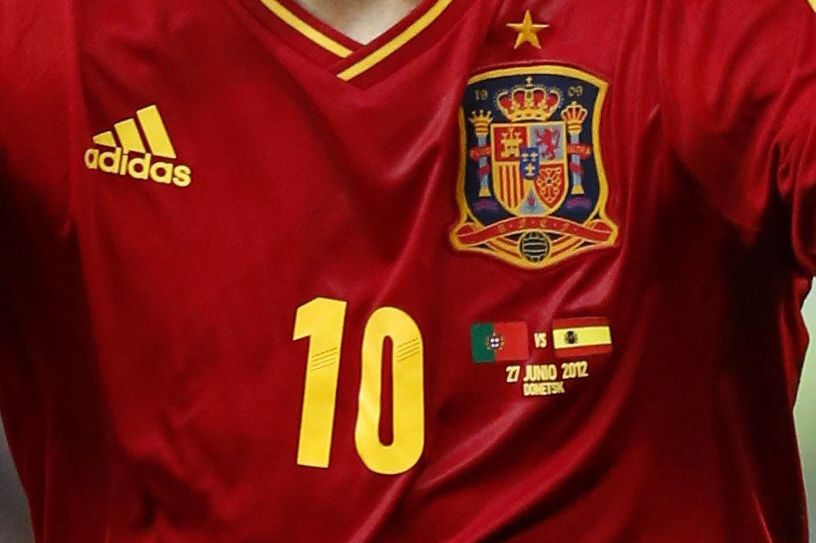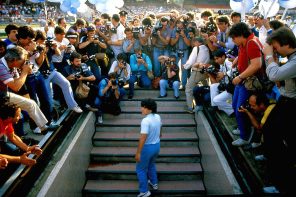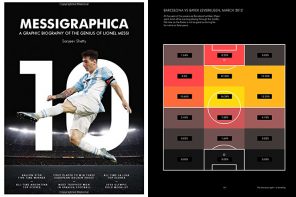Does Spain really hold football’s greatest number in high esteem?
Over the course of the last decade football’s beautiful game has shifted and its dance has changed. A slick new beat emerged from the land of the Flamenco and deposed of the Samba’s long established reign – the tiki-taka rhythm employed by Barcelona and Spain conquered hearts (as well as tournaments) on its way to becoming the new standard-bearer for o jogo bonito.
At first glance tiki-taka’s core philosophy, which preaches team-play over individuality, is seemingly at odds with the fantasisti – used to being the protagonists of the beautiful game for so long. So, does this mean the land of tiki-taka now views the role of a specific playmaker, obsolete? Did Spanish football, pre-tiki-taka, even have a tradition of employing a specialist Number 10?
Whilst Spain are now blessed with a plethora of highly technical, diminutive playmakers, prior to this current golden generation the country arguable hadn’t produced that stand-out superstar in the role – something that is in stark contrast when viewed alongside other Latin countries such as Brazil, Italy, France and Argentina who can boast the likes of Zico, Baggio, Platini and Maradona…the list could go on and on. Portugal? Rui Costa. Even Romania produced Gheorghe Hagi! But Spain?..
At this point it would be remiss of me not to mention Luis ‘Luisito’ Suarez of Barcelona and Inter Milan fame. After all, the midfield schemer from the 50s and 60s won the Ballon d’Or in 1960 becoming the first (and still, only) Spanish-born player to do so. However, as far as I’m aware, he had little to no association with the number 10 shirt, and whilst he started out as an inside forward, he became best known for his deep-lying schemer role at Inter Milan.
The influence of the foreign superstars – often considered the best players in their team and country – and their association with the number 10 shirt, inspired the proceeding generations to replicate; therefore, usually a forward-thinking player who has great technical skill and ability with the ball, along with the capacity to dribble well and score goals is associated with the number.
This synopsis could be true for most footballing countries around the world, but historically, the number 10 in Spain wasn’t admired as much, or viewed with such religious fervour as in Latin America/Europe, with the number 9s (great goalscorers) and goalkeepers being the most esteemed.
Culturally, the country wasn’t as obsessed with the essence of a 10, but with the ‘Furia Roja’ – when spirit, work ethic, speed and intensity were the truly valued attributes; a somewhat British attitude towards the game in general and one that Athletic Bilbao became synonymous with during the 80s. In this, the Spanish had more in common with the Brits; another footballing culture that historically doesn’t revere the shirt number, possibly for the same reasons.
Another factor is that, prior to the 80s, Spanish teams traditionally played with classic interiores (wingers who take up central positions when their team has the ball) who generally wore numbers 8 and 10. As both had the same role, the number 10 wasn’t seen as particularly special or unique. This, allied with the high proportion of historically great captains plying their trade at centre-half or central midfield, meant that it was they who generally captured supporters hearts.
There have, of course, been obvious exceptions to this in La Liga, but those feted playmakers were often imported. During the 70s a deluge of foreign players, signed by clubs attempting to fill the gaps in positions the nation wasn’t producing, led to regulations being introduced and players banned unless they were of Spanish origin. Of the imports, a huge percentage came from Latin America and managed to circumnavigate the rule, as Sid Lowe, The Guardian’s Spanish football correspondent revealed:
Looking back over Spanish football history, there is, naturally, a huge percentage of Argentinian players. That’s logical: culturally, linguistically, economically. Spain had a huge scandal with the ‘oriundos’ during the period when foreign players were banned but those with Spanish roots were allowed. Basically, lots of Latin Americans invented Spanish parentage to justify coming. Statistics gathered by a Barcelona lawyer at the time (1970s) showed that something like three quarters were here on false papers.
Did the increase of players from another footballing culture help influence the Spanish perspective on the way a number 10 should operate? It seems the importance of the number 10 shirt now, may well have derived from such South American influences.
Furthermore, whilst importing star playmakers suggested there was an appetite in Spain for players of vision and high technical quality, conversely it showed that the country wasn’t consistently producing their very own top-notch mediapunta – the Spanish term for the number 10; or simply, the Diez.
A fascinating interview with Liverpool FC’s Head of Academy Coaching, Rodolfo Borrell, illuminated the socio-economic circumstances which may have impacted, and still may impact, why certain types of players do not develop. Borrell was a Barcelona youth team coach for 14 seasons, overseeing starlets such as Lionel Messi and Cesc Fabregas amongst others during his time there.
When asked if he thought great number 10s have mostly been imported to La Liga because clubs put more of an emphasis on specific team-play at youth level coaching, rather than developing an individual’s talent for a specific role, he answered:
No, I would just say that we need to also understand football from a social point of view. What I mean is, in some societies and some countries, kids are still playing on the streets, beaches and parks. In other societies, it’s more dangerous [to play in those areas].
One time [at Barcelona] we studied what kind of players from the province of Barcelona we had in our youth system. And suddenly, we realised, that from the city centre, we had ‘one’. The rest were from the surrounding areas – the suburbs. This is another explanation: in the area where everything is just streets and cars, you cannot play on the street.
Also, in societies that have greater economic levels, the kids have a lot more things to play at home – this means if they have the PlayStation, plus many other things, possibly you’re spending more time on the sofa. [But] maybe if you don’t have any money, and you don’t have anything it’s very easy to get a ball, to share between 20 neighbours. This is a sport that you develop better if you practise as many hours as possible, like anything.
What does this mean? It means this profile of player is usually a player that is street-wise, is a fighter, but at the same time, skilful; a player with character, and personality. All of this is more easy to produce in an environment where you can still play on the streets because first: you’re playing on different surfaces – were dominating the ball is not that easy. Playing in a park which is full of holes where you have to take into consideration where you are running with the ball, you develop some skills that are fantastic for a number 10. Second, because when you play with neighbours or friends, some may be 12 years old playing against 18-21 year olds. Third, possibly the ball is not the best ball in the world and you are also adapting to that.
A player that grows in this environment – not everyone – but usually, will grow this profile of [a number 10] player. From this environment you have examples like Maradona, Cruyff, Pele, Messi, Aguero, Tevez…I wouldn’t say it’s because of the type of training sessions
A great insight from a man who was part of the famed La Masia academy which gave birth to the tiki-taka philosophy; the blueprint of which is seen as largely responsible for the technical emphasis Spain switched to at youth level. Years later, the Furia Roja is no more; a conscious effort was also made to strip out the fury. Now Spain’s ‘La Roja’ are benefitting from the vast rewards and have seemingly managed to create a modern-day number 10 cloning facility such has been the regularity of which they are now producing playmakers of a similar ilk – Iniesta, Mata, Fabregas, David Silva, Cazorla – would this diminutive lot have been produced if the emphasis was all on furia?
What else influenced Spain’s commitment to change, and when did they occur? Sky Sports’ Revista de la Liga correspondent Graham Hunter is convinced the answer is not solely roja, but also oranje:
I’m absolutely 100% sure the base reason is Cruyff. His impact when he came originally, to Franco’s Spain in ’73, playing and talking like he did at a time when the world was gushing over Total Football. Franco’s reign was coming to an end and there was an appetite for the new – this was the guy that came along. He set a template.
He left but was back around 10 years later and created that Dream Team which branded Spanish football and an era because they won the European Cup, the Cup Winners Cup, 5 straight leagues but also played with a verve and brand of football.
It was also during this period that the city of Barcelona held the 1992 Olympics with Spain’s football side winning Gold in dramatic fashion, capturing the nation’s imagination in the process. The euphoria generated in this atmosphere helped inspire the subsequent generations and cement an ideology in the way football should be played.
The aforementioned batch of diminutive playmakers fit perfectly within the tiki-taka philosophy and each can be held up as an example of a modern-day playmaker, with perhaps Iniesta and David Silva most closely resembling a classic number 10. Outside of that group, other standout names Spain have produced was the gifted (but never fully trusted) Guti at Real Madrid, the rare and initially outstanding Julen Guerrero at Athletic Bilbao and impish Ivan de la Pena at Barcelona, and the wonderfully slow-motioned Juan Carlos Valeron, who Graham Hunter affectionately labelled as:
Spain’s Zidane! He is an extraordinary footballer, I’m very fond of him. [At his age] you still see the intelligence, the appetite for winning – not just showing off.
A fitting tribute, which could be held true for all great playmakers, was paid by Graham in summing up Valeron:
I think as soon as you get into any discussion about a playmaker, you have to discuss whether they’re just on the pitch to look pretty or to be effective. Valeron is always, always applied to winning and the betterment of the team.
Compared with their Latin counterparts, Spain have been relatively slow into the relationship with the game’s most revered number and its cult; however after a generation was inspired and a conscious effort was made to ensure technique was valued above all else, the result has been two European Championships and a World Cup – with the magical, miniature playmakers at the fulcrum of the country’s success, all dancing to the tiki-taka beat.
Fantasista1o would like to give special thanks to…
– Sky Sports and ESPN’s Graham Hunter for his time and interview, providing his invaluable knowledge and help towards garnering content. You can catch Graham @BumperGraham.
– Liverpool FC, and Rodolfo Borrell for his time and interview, sharing his incredible insight and experiences with us.
– Angel Iturriaga for his time and help providing his historical knowledge on the Spanish game. You can find Angel @anituarco












I would like to point also a player like Michel, who in the 80’s also personified to a point the number 10. And, if i remember correctly, Bakero started playing for Barcelona more advanced, almost as a number 10 as well.
Still, I think that, on top of the changes brought about by Cruijf, the biggst reason for the rise of the tiki-taka were the changes in the rules. Today, the technical players are much better protected in the past, which means that many of them can be fielded together. If you had tried to introduce them agains, say, the crazy Gang, you’d be bound to see Vinny Jones looking like a chicken without a head most of the time, but when he did hit, he would just break some legs. Possibly without even seeing a yellow card. That makes a huge difference.
Hi Joao, thanks for the comment and interest in the article. I remember Michel also, a fine player, but thought him more of a wide midfielder – more akin to a winger – than a number 10. Bakero was also a great player and, initially at least, an offensive midfielder, but held combative qualities too, hence don’t see him as a playmaker.
No doubt Spain had produced fine players previously, just not – I believe – that ‘superstar’ number 10.
Agree totally that players are more protected today, but conversely, athleticism and structured systems have risen meaning the ‘classic’ playmaker role has all but died out.
Great article… but remember, there is NO FLAMENCO in Barcelona, or for that matter in Catalunya and all the regions north of the Murcia- Extremadura line.
And neither Sevilla nor the rest of the Andulucian teams had anything to do with Tiki Taka then you ought not to continue the stereotype.
It sort of bugs me watching American TV travel shows shot in Barcelona with flamenco music in the background. That’s so for tourists, you know?
Valeron was one of my favourite players to watch. I’m so glad you’ve mentioned him in this article. He played with such grace and intelligence. He never looked hurried and ran the great Deportivo team.
Michel was definitely a playmaker and very good one at that. Would have achieved more if Spain had a better team at the time
Sorry Tonye to deeply disagree with you, that you don´t like flamenco does not mean that it doesn´t belong to Catalunyan culture. Actually not Flamenco, but RUMBA CATALANA, that you can hear all around and it´s definetely not for tourists. North of the line Murcia-Extremadura of course there is a lot of flamenco, Madrid has always been a popular spot (it was there were Camaron, the greatest of all time, developed his career).
There were some fine playmakers on the 80s, Juan José of Real Madrid and Manu Sarabia of Athletic de Bilbao. Sarabia was a pure fantasista but Spain went through some the likes of some coaches (into the 90s also) like Javi Clemente that despised control and attacking football and prefered more of a tough, atletic game, in the line of the old british football.
And Michel was of course an amazing player, but not a number 10, he was an 8, a right wing. What a wonderful pass he had. Of the same generation probably Martin Vazquez was even more skilled, and closer to the figure of the 10, but used to play more as an interior.
To sum up, I think the skilled fantasistas have been there in the Spanish Football tradition, but, maybe due to a inferiority complex or just not believing in their own skills and trying to play with the arms of others, they have not been put toghether in the national football team, until Luis Aragones decided to do so.
Raul?! Ok, he wore number 7 but all his other traits were of a number 10 as you set out. He was captain of Real and Spain!